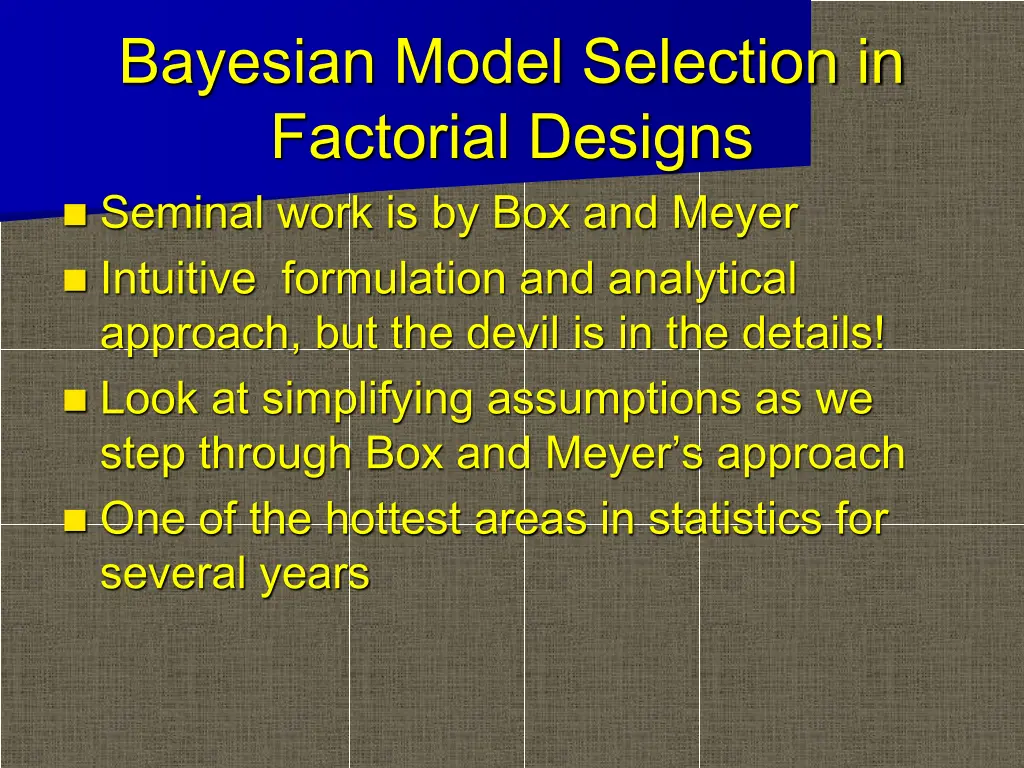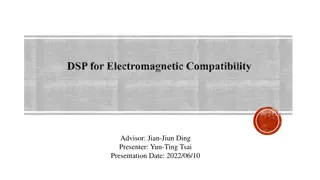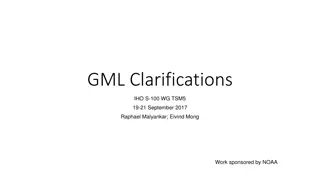
Bayesian Model Selection in Factorial Designs: Simplifying Box and Meyer's Approach
Explore the key concepts of Bayesian model selection in factorial designs as proposed by Box and Meyer. Dive into the intuitive formulation and analytical approach, with a focus on simplifying assumptions. Understand the active effects, normal linear models, likelihood functions, Bayesian paradigms, posterior density estimation, and Bayes estimator in the context of this influential statistical methodology.
Download Presentation

Please find below an Image/Link to download the presentation.
The content on the website is provided AS IS for your information and personal use only. It may not be sold, licensed, or shared on other websites without obtaining consent from the author. If you encounter any issues during the download, it is possible that the publisher has removed the file from their server.
You are allowed to download the files provided on this website for personal or commercial use, subject to the condition that they are used lawfully. All files are the property of their respective owners.
The content on the website is provided AS IS for your information and personal use only. It may not be sold, licensed, or shared on other websites without obtaining consent from the author.
E N D
Presentation Transcript
Bayesian Model Selection in Factorial Designs Seminal work is by Box and Meyer Intuitive formulation and analytical approach, but the devil is in the details! Look at simplifying assumptions as we step through Box and Meyer s approach One of the hottest areas in statistics for several years
Model Domain There are 2k-p=n possible (fractional) factorial models, denoted as a set {Ml}. To simplify later calculations, we usually assume that the only active effects are main effects, two-way effects or three-way effects This assumption is already in place for low- resolution fractional factorials
Active Effects in Models Each Mldenotes a set of active effects (both main effects and interactions) in a hierarchical model. We will use Xik=1 for the high level of effect k and Xik=-1 for the low level of effect k.
Normal Linear Model We will assume that the response variables follow a linear model with normal errors given model M:Yi~N(X Xi , ) Xiand are model-specific, but we will use a saturated model in what follows.
Likelihood Function The likelihood for the data given the parameters has the following form 2n 1 1 ( ) 2 2s2Yi- L(b,s,Y)= - Xib 2ps2exp 1 2s2Y -Xb i=1 1 ) Y -Xb ( ( ) = n2exp - ( ) 2ps2
Bayesian Paradigm Unlike in classical inference, we assume the parameters, , are random variables that have a prior distribution, f ( ), rather than being fixed unknown constants. In classical inference, we estimate by maximizing the likelihood L( |y)
Posterior Density Estimation using the Bayesian approach relies on updating our prior distribution for after collecting our data y. The posterior density, by an application of Bayes rule, is proportional to the product of the familiar data density and the prior density: ( ) fX|Q(x |q)fQ(q) fQ|Yq |y
Bayes Estimator The Bayes estimate of minimizes Bayes risk the expected value (with respect to the prior) of loss function L( ). Under squared error loss, the Bayes estimate is the mean of the posterior distribution: q y ( ) = EQ|YQ
Prior Likelihood The Bayesian prior for models is quite straightforward. The prior probability that r effects are active in the model, given each is active with prior probability is r p ( ) ( ) n-1-r=C11-p n-1 L(p)=C1pr1-p 1-p
Prior Likelihood for Linear Model Parameters Since we re using a Bayesian approach, we need priors for and as well b0~ N 0,s2e ( bj~ N 0,g2s2 ( s ~ g s ( ), g s ( ) s-a ), e =10-6 )
Zellners g-prior For non-orthogonal designs, it s common to use Zellner s g-prior for : ( ) ( ) -1 bj~ N 0,g2s2X'X Note that we did not assign priors to or
Complete Data Likelihood We can combine f( , , ) and f(Y| , , ) to obtain the full likelihood L( , , ,Y) 2n-1+a 2 n-1 r1 1 2s2Q(b) p 1 L(b,s,M,Y)=C 1-p g 2ps2 exp -
Expansion of Complete Data Likelihood Terms
Posterior Model Derivation Our goal is to derive the posterior distribution of M given Y, which first requires integrating out and . Rn L(M |Y) L(M,Y)= L(b,s,M,Y)dbds = 0 ( ) -1 2 XX +G n-1 r1 p C ( ) (n-1+a) 2 1-p g ( ) -1 XX +G Q XY
Posterior Model Partition The first term is a penalty for model complexity (smaller is better) The second term is a measure of model fit (smaller is better)
Posterior Model Distribution and are still present. We will fix ; the method is robust to the choice of is selected to minimize the probability of no active factors
Posterior Model Selection With L(M|Y) in hand, we can actually evaluate the P(Mi|Y) for all Mifor any prior choice of , provided the number of Miis not burdensome This is in part why we assume eligible Mi only include lower order effects.
Selection Criteria Greedy search or MCMC algorithms are used to select models when they cannot be itemized Selection criteria include Bayes Factor, Schwarz criterion, Bayesian Information Criterion Refer to R package BMA and bic.glm for fitting more general models.
Marginal Selection For each effect, we sum the probabilities for all Mithat contain that effect and obtain a marginal posterior probability for that effect. These marginal probabilities are relatively robust to the choice of .
Case Study Violin data* (24factorial design with n=11 replications) Response: Decibels Factors A: Pressure (Low/High) B: Placement (Near/Far) C: Angle (Low/High) D: Speed (Low/High) *Carla Padgett, STAT 706 taught by Don Edwards
Case Study Summary Fractional Factorial Design: A, B, and D significant AB marginal Bayesian Model Selection: A, B, D, AB, AD, BD significant All others negligible *Carla Padgett, STAT 706 taught by Don Edwards



















